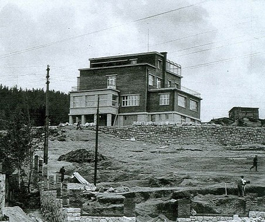
The state sold a functionalist first-republic villa in Jablonec
 |
| Oldřich Liska, villa of Rudolf Hásek, Jablonec nad Nisou, 1926 - 1927, historical photo during construction |
The four-story building was constructed in the 1920s by the legionnaire and jewelry trader Rudolf Hásek. It is located in a lucrative and quiet area about three kilometers from the center. It stands next to the house of Hásek's brother Jaroslav. "Both houses, referred to as the Hásek Villas, are an example of traditionalist-oriented modernism and are considered one of the most valuable functionalist villas in our territory," the spokesperson stated.
The state acquired the building in 1997. The local school authority purchased the villa from Věra Tancibudková, the daughter of Rudolf Hásek. "He wanted to use the building for educational purposes. From 2000 until July 2015, the Basic Catholic School was located in the building. The new owner plans to restore the villa's original appearance and use it again for residential purposes," Ležatka said. Two interested parties vied for the house with the adjoining garden, both willing to pay the state the requested 4.989 million crowns. In a subsequent auction, the price was successfully increased by about 400,000 crowns.
Rudolf Hásek was the commander of the assault battalion of the Czechoslovak legions in Russia during World War I. After the war, he and his younger brother Jaroslav founded a company that eventually became the largest Czech exporter of jewelry. His family residence was built between 1926 and 1927 by the prominent Czech architect Oldřich Liska.
The architect ingeniously utilized the contrast between the rough, unplastered walls and the sprayed, brizolit finish in Hásek's villa, which enlivened an otherwise fairly simple, cubic structure of the house. "In the layout design, Liska built on the still-popular type of English hall house," Ležatka noted. The representative spaces - the living room and library with a study - were oriented toward the garden and provided an impressive view of the surrounding landscape. The attic housed sun baths, which, however, have not survived. Hásek lost the villa during the nationalization after the communist coup in 1948. His family subsequently emigrated from Czechoslovakia and settled in Canada. They regained the villa in 1991.
The English translation is powered by AI tool. Switch to Czech to view the original text source.
0 comments
add comment












